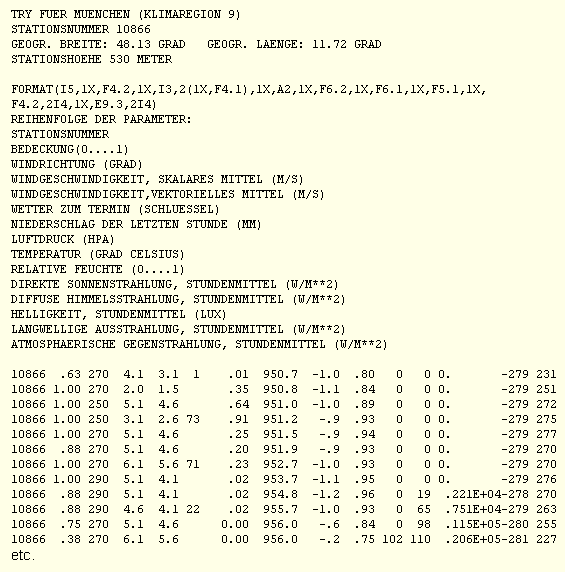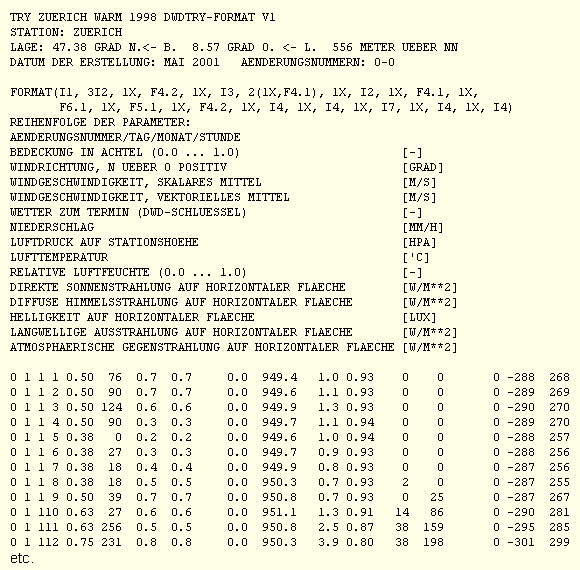Details:TRY-File
The *.TRY Format for Climate Data
You can use existing TRY weather files (file format *.TRY) to perform WUFI calculations; you can also convert your own weather data to that format and use them.
This format was used by the German National Weather Service DWD for the test reference years published in 1986 (the new test reference years, published in 2004, are in *.DAT format). Also, this format was used for some of the climate files supplied with WUFI.
The 1986 test reference years (TRY) cannot be purchased from DWD any more (they have been replaced by the 2004 test reference years), but existing old TRY can still be used with WUFI. They contain synthetic hourly climate data which - based on seasonal mean values and long-term annual mean values - represent typical weather conditions for different geographical regions [1].
Please note that these (1986) test reference years may be of limited usability for calculating the moisture balance of building components, since they have been designed for thermal simulations only. The total amount of precipitation is reproduced correctly, but the number of hours with precipitation is overestimated [2]. With building materials of low absorptive capacity, however, the duration of precipitation is more important than the amount of precipitation.
WUFI can read two different variants of the TRY format: the IBP variant and the DWD variant.
IBP variant
TRY weather files consist of 24 lines of header and 8760 lines of weather data in hourly intervals.
Example:
WUFI skips the header, with the exception of lines 3 and 4, from which it reads the geographical position of the measuring site.
Since the file format is a remnant from the FORTRAN era, the column-oriented structure of the file has to be followed strictly. It is not necessary, however, to stick to the exact floating point format of the numbers themselves: for example, WUFI reads columns 42-47 as a string and then converts it to a real number.
A TRY file contains 8760 data lines with hourly weather data. The first one of these consists of the mean weather data for the hour from 0:00 to 1:00 CET on January 1. There is no intercalary day (February 29).
The meaning of the weather data in detail:
- Column 1-5: site ID.
Not used by WUFI.
- Column 6-10: cloud cover (0..1).
Currently not used by WUFI.
- Column 11-14: wind direction [degrees] (0..360).
Counted clockwise from north (0°) over east (90°).
- Column 15-19: wind velocity, scalar mean [m/s].
Not used by WUFI.
- Column 20-24: wind velocity, vectorial mean [m/s].
Since no wind direction distributions are provided in the TRY files, this loss of information must be compensated by using the vectorial mean instead of the scalar mean.
The vectorial mean of the wind velocity is the mean value of the readings of an anemometer with the directions taken into account. For example, if for an hour the wind is blowing at 2 m/s but at the same time steadily travelling through all the directions, then the vectorial mean is 0 m/s, whereas the scalar mean is 2 m/s.
In the vectorial mean, some vector components may cancel. Thus, the vectorial mean is always less than (or at most equal to) the scalar mean.
If only the mean direction and velocity are provided, no individual treatment of specific directions is feasible anymore. Therefore, it is not possible to disregard wind directions which hit the building component from behind and thus don't contribute to the rain load. In a driving rain situation, however, the wind will mostly blow from a narrow range of directions, so that the mean direction will be reasonably representative.
- Column 25-27: DWD code for regular weather observations.
Not used by WUFI.
- Column 28-34: precipitation during the last hour [mm].
The rain load on a wall is determined by the driving rain rather than the normal rain. If no measured data on the driving rain are available, it can be estimated from other data.
The rain coefficients R1 and R2 in the dialog "Edit Surface Coefficients" serve to estimate the driving rain load on a surface of arbitrary orientation and inclination from data on normal rain, wind velocity and wind direction, using the relation
rain load = rain · (R1 + R2 · wind velocity),
where 'rain' is the normal rain and 'wind velocity' is that component of the mean vectorial wind velocity (measured at a height of 10 m, in open area), which is orthogonal to the building surface.
R1 and R2 are strongly dependent on the specific location on the building facade. If calculations are to be compared to actual measurements, these coefficients should be experimentally determined for that location.
If they cannot be measured, only a very rough estimate is possible. For vertical surfaces, R1 is zero. R2 is about 0.2 s/m for free-standing locations without influence from surrounding buildings etc.; it is markedly less in the center of a facade (e.g. 0.07 s/m); it may even be greater at exposed locations of a building (near edges and corners) [1].
- Column 35-41: ambient air pressure at height of location [hPa].
The actual (i.e. not reduced to sea level) barometric pressure at the measurement location. The barometric pressure affects the vapor diffusion coefficient in air.
- Column 42-47: air temperature [°C].
Adopted by WUFI without change as the exterior air temperature.
- Column 48-52: relative humidity [-] (0..1).
Adopted by WUFI without change as the exterior relative humidity.
- Column 53-56: direct solar radiation [W/m²].
The direct component of the solar radiation (i.e. received directly from the sun) incident on a horizontal surface.
From this, the direct normal radiation can be calculated, i.e., the amount of radiation incident on a surface that is orthogonal to the beam direction [3]. This calculation requires knowledge of the time and geographical location of the measurement, since the corresponding position of the sun has to be determined.
&bnsp;
The direct normal radiation can then be used to calculate the direct radiation incident on a surface with arbitrary orientation and inclination. Addition of the appropriate fraction of diffuse radiation results in the global radiation incident on the building component.
These calculations are automatically done by WUFI during a simulation run. WUFI uses a simplified radiation model which treats the diffuse radiation as isotropic and ignores the albedo of the ground. If you are more demanding or want to allow for local specifics (like shadows etc.), you can perform the conversion yourself and feed the results to WUFI via a *.KLI file.
- Column 57-60: diffuse sky radiation [W/m²].
The diffuse component of the solar radiation (scattered by the atmosphere or clouds), incident on a horizontal surface.
- Column 61-70: illuminance [lux].
Not used by WUFI.
- Column 71-74: long-wave radiative emission [W/m²].
Not used by WUFI.
- Column 75-78: atmospheric counterradiation [W/m²].
The thermal radiation of the atmosphere, incident on a horizontal surface.
Please refer to the topic Long-wave Radiation Emissivity for a description of when and how to use counterradiation data and what to do if you have no counterradiation data.
DWD variant
Example:
The difference between the IBP variant and this one lies only in the different header and the slightly different column format. The data are the same as in the IBP variant.
| • | Column 1: | update index (not used by WUFI) |
| • | Column 2-3: | day (not used by WUFI) |
| • | Column 4-5: | month (not used by WUFI) |
| • | Column 6-7: | hour (not used by WUFI) |
| • | Column 8: | blank |
| • | Column 9-12: | cloud cover in eighths (currently not used by WUFI) |
| • | Column 13: | blank |
| • | Column 14-16: | wind direction [degree] |
| • | Column 17: | blank |
| • | Column 18-21: | wind velocity, scalar mean [m/s] (not used by WUFI) |
| • | Column 22: | blank |
| • | Column 23-26: | wind velocity, vectorial mean [m/s] |
| • | Column 27: | blank |
| • | Column 28-29: | DWD code for regular weather observations (not used by WUFI) |
| • | Column 30: | blank |
| • | Column 31-34: | precipitation [mm/h] |
| • | Column 35: | blank |
| • | Column 36-41: | air pressure at height of location [hPa] |
| • | Column 42: | blank |
| • | Column 43-47: | air temperature [°C] |
| • | Column 48: | blank |
| • | Column 49-52: | relative humidity [-] (0..1) |
| • | Column 53: | blank |
| • | Column 54-57: | direct solar radiation on horizontal surface [W/m²] |
| • | Column 58: | blank |
| • | Column 59-62: | diffuse sky radiation on horizontal surface [W/m²] |
| • | Column 63: | blank |
| • | Column 64-70: | illuminance on horizontal surface [lux] (not used by WUFI) |
| • | Column 71: | blank |
| • | Column 72-75: | long-wave emission from horizontal surface [W/m²] (not used) |
| • | Column 76: | blank |
| • | Column 77-80: | atmospheric counterradiation on horizontal surface [W/m²] |
A *.TRY file supplied by the user must be accompanied by a *.AGD file which contains additional geographical information on the climate location.
Literature:
| [1] | Blümel, K. et al.: Entwicklung von Testreferenzjahren (TRY) für Klimaregionen der Bundesrepublik Deutschland. BMFT-Forschungsbericht T 86-051. |
| [2] | Künzel, H.M.: Regendaten für die Berechnung des Feuchtetransports. IBP-Mitteilung 21 (1994), Nr. 265. |
| [3] | VDI 3789 Umweltmeteorologie, Blatt 2: Wechselwirkungen zwischen Atmosphäre und Oberflächen; Berechnung der kurz- und der langwelligen Strahlung. Oktober 1994 |

